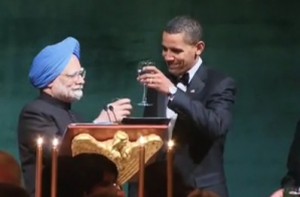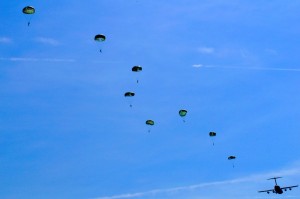 Compared to domestic coverage of Obama’s trip to India over the weekend, the South Asian press was generally more forthright about the purpose of the US President’s visit: Convincing India to buy military hardware from America instead of Russia.
Compared to domestic coverage of Obama’s trip to India over the weekend, the South Asian press was generally more forthright about the purpose of the US President’s visit: Convincing India to buy military hardware from America instead of Russia.
Strangely, only Americans seem to think Obama went to India as some kind of spendthrift tourist—or consider such a ridiculous idea even worthy of discussion. The South Asian press, by contrast, does not hesitate to note that Obama arrived, following his Secretary of State, as a sales agent for top US military contractors.
Columns like this one from Rising Kashmir are typical:
Obama’s visit has more to do with weapons sales [than politics. His visit] is part of a race world powers are in, to strike a big deal in the history of defence agreements…
Moreover the United States and European nations have already trimmed military spending and the biggest weapons contractors including Boeing and Lockheed Martin see India as a sales lifeline.
If it matters to Americans, it’s printed in Srinagar.
Here’s another example where, once again, American audiences were given only the bare outlines of a much more disquieting story, lest they start to doubt their government’s role in the world.
 It begins with a November 1 press release from US Rep. Ed Royce (D-California), advocating for increased US “defense cooperation” with India in advance of Obama’s trip there. Who could oppose something so gentle-sounding as “cooperation”? But a letter quoted at length by the Press Trust of India makes clear that Royce gave far more explicit instructions to the Salesman-in-Chief:
It begins with a November 1 press release from US Rep. Ed Royce (D-California), advocating for increased US “defense cooperation” with India in advance of Obama’s trip there. Who could oppose something so gentle-sounding as “cooperation”? But a letter quoted at length by the Press Trust of India makes clear that Royce gave far more explicit instructions to the Salesman-in-Chief:
“As you know, six foreign companies are competing to sell India 126 new multi-role combat aircraft in a deal that could be worth as much as $11 billion. India’s selection process for this aircraft is advancing, with two US companies under active consideration,” senior Republican lawmaker from California Ed Royce said in a letter to Obama…
Royce, in his letter of October 26, said heads of state from France, Russia and the United Kingdom were moving aggressively to advocate for their countries’ aircraft proposal.
“Moving India away from its tradition of purchasing Russian equipment toward a US supplier would provide New Delhi with the best product, enhance Indian military’s role in the region and improve interaction amongst our militaries,” he wrote…
Royce, who has put himself forward as a candidate for the House Foreign Affairs Committee, took at least $24,000 from defense industry political action committees in the just-finished 2010 election cycle. (Obama took more than $1 million from the industry for his 2008 campaign.)
To be fair, the US media didn’t completely ignore the real reason for Obama’s trip—they just tended to gloss over the details of the transaction in favor of happier angles.
CNN.com—at least, its adult-friendly international edition—made prominent mention of “a $4.1 billion agreement for the Indian air force to purchase 10 C-17 military transport planes from Boeing, which the White House said will support more than 22,000 jobs.”
In a November 6 speech, Obama described those planes as “commercial and cargo aircraft,” which sound less, well, warlike. The photo below shows US Air Force paratroopers jumping from a C-17 during NATO exercises.
Politico quoted Boeing chairman W. James McNerney, who
told reporters in Mumbai that Obama’s advocacy on behalf of his and other American companies was a key. “Having the president here, it helps,” he said.
Anybody have a problem with the President as corporate pitchman? No? Granted, it’s nothing new. Okay, moving on…
The New York Times had the least piecemeal take, devoting an entire story to India as a “rich arms market.” But the Times left no room for critics of arms proliferation, treating advanced weapons as just another commodity, no different than rice or laptop computers.
For criticism of Obama’s mission, you had to seek out a paper like India Today, which offers a thorough, if somewhat nationalistic, analysis of US policy in South Asia. The authors say America’s practice of charging India for advanced weaponry while practically donating similar gear to Pakistan—all the while knowing that Pakistani intelligence aids the Taliban—”takes the last bit of morality out of Obama’s war in Afghanistan.”
Since 2001, Pakistan has received $3.2 billion in US military assistance for the war on terror. Mullah Omar and Osama bin Laden do not have a navy or an air force; yet 90 per cent of Pakistan’s defence acquisitions have been fighter aircraft, anti-ship missiles, anti-tank helicopters and missiles and long range maritime patrol aircraft…
The US aid is being used to gradually whittle down India’s conventional military advantage.
The more weapons the US gives to Pakistan, the more India wants to buy, lest it lose its edge. Exporting weapons may not promote “stability,” but it sure does boost demand.
